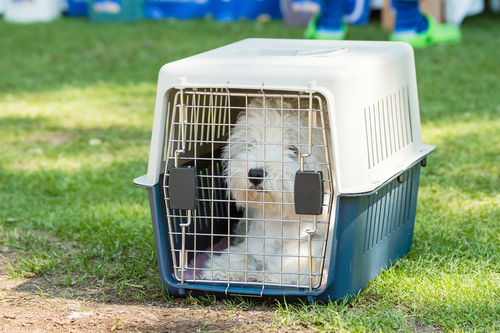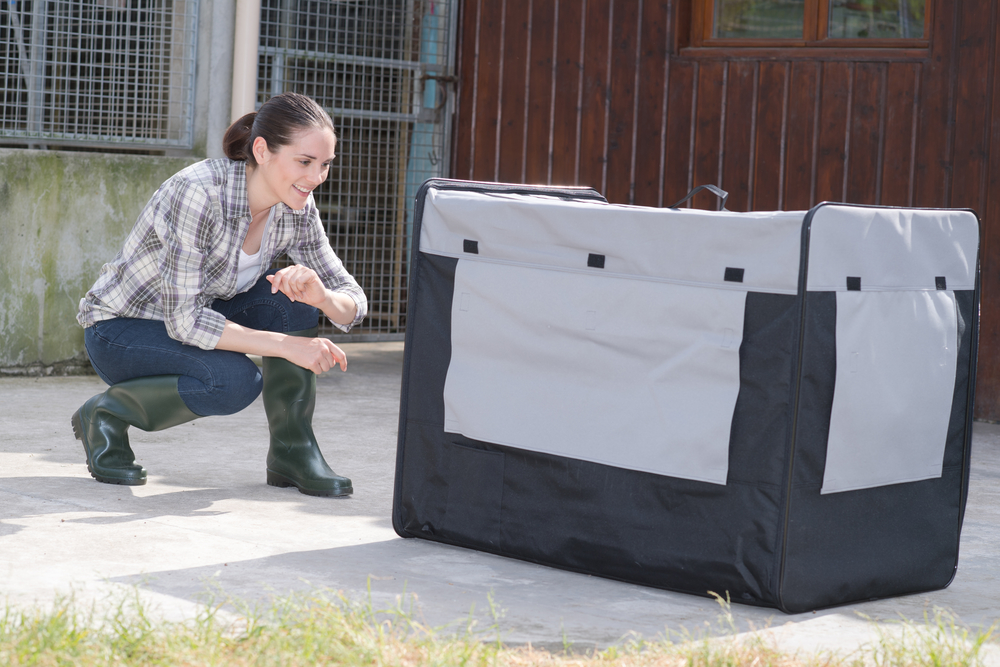How to Properly Crate Train a Puppy
Are you ready to learn the tried-and-true training techniques to teaching your puppy to be crate-trained? Read the article below or click to watch the video!
Crate training, when done properly, is beneficial for both you and your pup. It’ll be a huge challenge. But, once your pup gets the hang of it, you’ll have an easier time at home. Puppy will be happier too, making it a win-win situation for all.
Is Crate Training Cruel?
Wild dogs have dens that serve as their sanctuary. It’s where they sleep, rest, care for their family, and hide from intruders.
Domesticated dogs, on the other hand, have crates where they can rest and feel safe. Dogs, especially puppies, should not be left alone for an extended period of time.
Whether crate training is cruel depends on the methods a person is using, how long they stay in a crate, etc.

Benefits of Crate Training Your Pup
- Potty training your pup. Dogs will not want to soil their beds so once they are let out of their crate, they will need to relieve themselves. Your furry family member needs to learn there’s only a designated spot at home that they can use as their bathroom. Crate training is one way you can establish this.
- Teaching pup the house rules. Crate training your pup allows you to limit their access into your home. It’s an opportunity to teach your puppy what they can and can’t chew and where they can only do business. You can leave the house in peace knowing you will not come back to a horrible mess.
- Making travels more manageable. During long travels with your puppy or trips to the vet, it’ll help if they’re already used to staying in a crate. They’ll be comfortable while in transit. They won’t feel scared or feel they’re being caged.
Choosing the Right Crate
Chances are you’ll come across three types of dog crates.
First is the plastic crate, which can be costlier although is commonly used for travels. It also allows a limited view of your dog while they’re inside.
Second is the metal crate, which can be adjusted according to the size and needs of your dog. This type of crate also allows you to see in full what your dog does while they’re in.
Third is the fabric crate. This type is collapsible and may also be used during travels. However, the problem comes in when your pup causes accidents. This crate will be harder to clean.
Overall, the crate should not be too wide that your pup will think it’s okay to relieve on one side and sleep on the other. Its size should be enough for their bed to fit in and for them to stand and move around comfortably.
Where Should You Place the Crate
Puppy should not feel they’re being separated from the family. Otherwise, they might think they’re being punished. They love social interactions, they love seeing you.
That being said, be sure to position the crate where the action is. It could be in the living room or in the kitchen. The bottom line is to not make feel your pup alone.
What Should You Place in the Crate
It depends on your puppy. The general rule is to only put items in the crate that you’ll feel comfortable leaving them with.
If your dog loves chewing on everything, then you need to choose a mat or bedding that will hold up. For puppies, consider leaving a soft toy for them to play with.
If you’ll be around and might only leave for 2-3 hours maximum, it isn’t necessary to leave a water in their crate.

Crate Training Tips for Your Puppies
1. Introducing pup to their crate.
Don’t rush your dog. If they don’t seem interested at first, that’s okay. Keep trying.
To help encourage them to enter the crate, use treats. Toss some inside the crate and see if they will go inside to get them.
If that doesn’t work, you can also try using toys to lure them in.
2. Feeding time.
The number one rule is for your pup to associate the crate with pleasant thoughts.
If they enter the crate when you place some treats in, then you can move forward to feeding them inside their crate. If they still feel shy or reluctant, don’t place the food too far.
If they willingly enter, on the other hand, then you can push the food at the back end of the crate.
When you see them happily eat and stay in the crate for a few minutes after eating, close the door. Little by little, extend the time you’re closing the door while they’re in. If they whine, this may mean you’re going fast.
But be careful not to give in and let them out right away. When you do so every time they whine, they will think that whining will mean they can get out of the crate.
3. Training them to stay in their crate longer.
Once pup gets used to eating at their crate, you can practice leaving them for short periods of time.
Encourage them to enter the crate and when they do, praise them for doing a job and give them a treat. Close the door and then leave for about 5-10 minutes.
Afterward, go back and sit beside the crate. Interact with your pup and then leave again after 5-10 minutes.
Come back again the third time, sit beside the crate, and let them out after a few minutes. Repeat the process until your pup shows no anxiety or frustration.
4. Crating puppies for a longer period.
Once you see they already feel comfortable being in their crate for a few minutes, it’s time to try to leave them for a longer period.
Repeat the same steps as number 3 but this time, leave for about 20-30 minutes.
This step is beneficial if you’ll be out for work or errands, but remember to make arrangements so your dog can also go outdoors and exercise.
5. Crating them at night.
At night, you may take the crate in your bedroom so you’ll hear them when they call your attention to relieve themselves.
Putting their bed beside yours will also make them feel safer. It’s a great opportunity to get close again to them after consecutive crate training sessions.
Once you have already observed their bathroom times, set your alarm accordingly. Adjust when they whine before your alarm goes off. When you wake up to take them to their bathroom, be sure not to play with them.
How Long Will it Take to Crate Train a Puppy
It depends on every puppy. It may take weeks or months even. Some breeds are more attached to their owners. Take baby steps and be patient.

